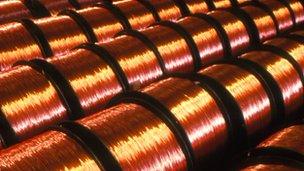Dundee University say 'laser technique' makes copper more useful
- Published

Copper is already one of the most commonly used metals in the world
Researchers at the University of Dundee believe they discovered a technique to make copper even more adaptable and efficient.
Scientists have found that blackening the element using lasers can transform the metal's properties.
They used intense nanosecond pulses of laser light to turn the metal's lustrous surface a deep black.
Blackening copper allows it to absorb more light and heat, increasing the range of uses for the metal.
Copper is already one of the world's most widely used metals; it is used as a conductor of heat and electricity, a building material, and a constituent of various metal alloys.
Prof Amin Abdolvand and his team at Dundee used industry-standard lasers for the process.
Absorbent copper
Previously it was thought that only much more expensive lasers (ultra-short pulsed lasers) could be used to make metals appear black, thereby making the process impractical for industrial use.
Prof Abdolvand said: "By making copper so much more light and heat-absorbent it means we can do so much more with it.
"Because copper is normally shiny it reflects most of the light back. Blackening it allows it to absorb light throughout a broad spectrum, making it far more effective.
"This technique for fabrication of black copper could find applications in broadband thermal radiation sources, solar energy absorbers, irradiative heat transfer devices, and thermophotovoltaics."
He said the potential uses for the laser blackened copper are many.
Practical applications
"Copper and its alloys and metals with similar metallurgical behaviour are important materials for many technical applications due to their unrivalled thermal and electrical conductivity.
"Affordable and practical routes for processing of such metals are essential for us to meet our ever growing energy demands and much higher electrification of our everyday lives."
The team found that by "stepping" the laser beam over the surface of the copper, they were able to modify the properties of the copper.
Under a microscope the modified surface resembles an upturned egg carton whose individual dimples have been pushed in.
The researchers tested various firing patterns for the laser before finding the most effective pattern, which gave the greatest boost in absorption.
Prof Abdolvand added: "Importantly we are able to exercise full control over the structuring process, using nanosecond lasers.
"These lasers are already used widely in industry, so the process is one we think could have widespread application."
- Published12 December 2012
- Published21 November 2012
- Published16 November 2012
- Published12 November 2012